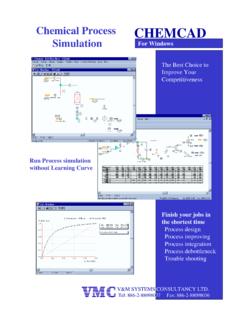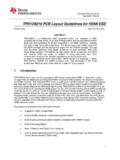Transcription of Improving Patient Flow and Resource Utilization in …
1 Vincent Chow1 John French1 Martin Puterman2 Pablo Santibanez1 Scott Tyldesley1 Greg Werker2 Methodology Improving Patient Flow and Resource Utilization in an Improving Patient Flow and Resource Utilization in an ambulatory Cancer Clinic through simulation ModellingAmbulatory Cancer Clinic through simulation Modelling Site of consultation for cancer outpatients with physicians and clinicians Located at the Vancouver Centre, largest of five centres in the province Provides three types of treatment programs: Medical Oncology, Radiation Oncology and Surgical Oncology There are three Patient types within each program: New patients (NP), Follow-up patients (FU) and Inter-program Consult patients (C) About 200 patients per day; more than 50,000 appointments in 2007/2008 A typical Patient flow: 2.
2 Modelling 1. Data Analysis Results Wait Time Reduction Exam Room Reduction 1 2 3 2 vs. Dedicated Room Allocation Dynamic Room Allocation Scenarios with the lowest Patient wait time and clinic end time are preferable and are located on or near the Efficient Frontier Results show that up to a 70% reduction in Patient wait time can be achieved with only a slight increase in clinic duration Clinics Exam Rooms # Rooms patients Schedule data from information systems Time study data from data collection Recommendations Under the current Dedicated Room Allocation configuration, each clinic is designated a fixed number of exam rooms In the proposed Dynamic Room Allocation configuration, clinics within each program can share the same pool of rooms Using Dynamic Room Allocation policy adds flexibility to the system Up to ten of the 38 existing exam rooms can be freed up with almost no impact on wait times What if?
3 Scenarios were tested using the model to determine the impact on Patient wait time, clinic duration and Resource Utilization Tested scenarios are a combination of the following factors and corresponding levels: Selected modelling technique is discrete event simulation Encompasses Patient flow from arrival until exam room departure, seizing limited resources such as doctors and exam rooms Incorporates randomness and variability present in the process ( random Patient arrivals, doctor arrivals, consultation durations, process times, etc.) Considers multiple clinics, participation of students and residents, and multiple exam rooms Validated against collected data; deemed accurate for analysis 100 one-month replications simulated, each month comprising 911 clinics and 4,435 patients Allocate exam rooms more flexibly and dynamically among clinics and programs ( Medical, Radiation and Surgical Oncology) Promote punctuality to avoid delays in the start and running of the clinic Schedule realistically ( avoid double booking add-ons and account for variability) to reduce Patient wait times Re-evaluate scheduling practices (for each physician) to ensure accurate booking of appointments Pilot recommended changes on several clinics followed by the entire ACU Utilize model to support future renovation initiatives We thank Dr.
4 Kim Chi, Lorna Roe, Frankie Goodwin, Michelle Dumas, Pam Stewart, Lindy McKinnon, Pam Taheem, Krystyna Olkiewicz, Suzanne Ratchford and Antoine Saure for their contributions during the course of this project We are also grateful to BCCA s physicians, nurses and clerical staff for their valuable input and cooperation Qualitative data from staff and physicians on pressure points 3. Scenario Analysis Lack of exam rooms, physicians space and Patient waiting area to provide optimal care for patients Increasing Patient volumes, with 9% annual increase over last five years Increasing demand for clinical trials, academic / teaching duties and new information technology assisted care ( electronic charts and tele-health) are changing Resource requirements at the ACU Concern about the Patient experience ( excessive wait times)
5 During their visit to the centre simulation Model Clinic schedules Student/resident participation Exam room allocation Resource availability Others Input Output Patient wait time Clinic duration Doctor idle time Exam / wait room Utilization Survey data from patients on their experience Cayirli T, Veral E, Rosen H (2006) Designing appointment scheduling systems for ambulatory care services. Health Care Management Sci 9: 47 58 Sepulveda J, Thompson W, Baesler F, Alvarez M, Cahoon L (1999) The use of simulation for process improvement in a cancer treatment center.
6 Proceedings of the 1999 Winter simulation Conference 1541 1548 Redistribute clinic workload more evenly across the week and time of the day (more balanced workload) Inform patients of anticipated wait times per doctor Allow patients to wait in the waiting room instead of the exam room Establish wait time standards and redesign processes to meet them: 90% of the patients should wait no longer than 20 minutes Perform a full scale Patient satisfaction survey Utilize findings from Patient survey, staff input and data analysis to support future renovation initiatives simulation Recommendations Additional Recommendations 1 2 3 2 Clinics Exam Rooms # Rooms patients 1 BC Cancer Agency: 600 West 10th Avenue, Vancouver BC, Canada V5Z 4E6 2 University of British Columbia: 2053 Main Mall, Vancouver BC, Canada V6T 1Z2 The CIHR Team in Operations Research for Improved Cancer Care is a CIHR-funded research collaboration between University of British Columbia's Sauder School of Business and the British Columbia Cancer Agency.
7 The overall goal is to develop, test and implement modern management practices, especially from the field of Operations Research, to increase the efficiency of the cancer system and to enhance Patient outcomes. For more information: , in Average Wait TimeChange in Clinic DurationCurrent Case Each point represents a scenario with a unique combination of factors Decreased Wait for Patient and Clinic Efficient Frontier Clinic StartAppointment orderAppointment DurationAppointment Add-OnsAppointment AdjustmentExam RoomsCurrentCurrentCurrentCurrentCurrent CurrentClinic on timeFU-C-NP15% increaseSchedule to the end of the clinicAdjust to average oncologist turnaroundPooled pod configurationNP-C-FU30% increaseFU-NP-CMain References Acknowledgements 04080120160 MonTuesWedThursFri# AppointmentsAM ClinicPM Clinic010203040-100-60-202060100 Wait Tim e# of cases0%20%40%60%80%100%%Appointment Time to FirstPhysician%0510152025303540101214161 8202224 Exam Room
8 CapacityAverage Wait TimeMedical OncologyRadiation OncologyCurrent Capacity Current Capacity No Significant Change No Significant Change Change in Wait Time vs. Change in Clinic Duration for Tested Scenarios Sensitivity Analysis on Exam Room and Wait Times Under Dynamic Room Allocation 0%20%40%60%80%100%120%CurrentDoc On TimeDoc On TimeDoc On TimeDoc On TimeSched Work InsSched Work InsSched Work Insappt dur +15%appt dur + 30%Changes to Current State% of Current LevelAverage Wait TimeAverage Clinic DurationWait Time and Clinic Duration for Selected Scenarios Appt. volume by day of week Patient wait time for doctor Background ambulatory Care Unit (ACU) Problems Wait for Doctor Reception Waiting Room Wait for Doctor Preparation for Doctor Wait for Exam Room 2nd Consult and Exit Room 1st Consult Arrival Waiting Room Wait for Discharge Value added time Non value added time One of the aims of the project is to reduce non value added time







